Additional Info On Maru's Mission
You probably don't care, but I love going the extra mile to uncover as much information as possible. Since Maru's Mission (as of this typing) is the only Jajamaru game that the U.S. ever got, I think it is more than fair for anyone to know what they might have missed out on...either from past games or things lost in the passage of localization. This is going to uncover pretty much all the differences between the U.S. and Japanese version. Believe it or not, there are more differences than you might think.
AHEM! First, let's begin with the title screens shall we? Besides the obvious language difference, there are sprites that aren't present in the U.S. game. The character on the left of the Japanese image is actually what Cori (girl you rescue in the U.S. game) originally looked like. Instead of looking like some gal who wants to paint the town red, she is just some simple looking villager of sorts. However, she is Princess Sakura and she is the girl you must rescue in the Japanese game (Oira Jajamaru! Sekai Daibouken). The hero is called Jajamaru in the Japanese game and the name was shortened to Maru in the U.S. game. Notice the frog he is on...I will mention it again. Anyway...BEHOLD! WITNESS MY NINJA POWER!
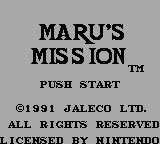

Now, you have the intro and maps. There is only one U.S. screenshot that you should notice for the intro. The background is in a city. In the U.S. game, you start your quest in America. The Japanese game has a different intro and you start in Japan. The villain in the air of the U.S. screenshot is Muramasa, ruler of all (basically put, he's some generic samurai). The villain in the air of the Japanese screenshot is actually Satan...well...we at least know why THAT was changed in the localization process. Now you understand why this game was mentioned in October! Another thing you should notice is the location of the white dots on the map screenshots. Despite the maps looking different (despite the fact that you visit most of the same levels...), the white dots are in different locations. There is also some Engrish going on in the Japanese version. Besides the misspelling of "Romania", they simply say "Let's Go Rumania!" instead of "Let's Go To Romania!". The absence of the word "To" is not only done once in the Japanese version, it is done for every new area you visit on the map.
The map is also important because of the navigation arrow on each map. In the U.S. version, the arrow starts on the right and travels to the left whereas it is the exact opposite in the Japanese game. The reasoning for this is because you start in America with the final level being in Japan in the U.S. version. You start in Japan with the final level being America in the Japanese game. It's also important to note that the final level BGM in the U.S. game acts as the first level BGM of the Japanese game (and vice versa) for that very reason. However, due to the progression of the game and level placement, the Japanese game naturally makes more sense...at least as far as plot is concerned. It seems strange to start in a forest in the U.S. game when Cori is taken away from the city whereas it seems more logical to start in a forest in the Japanese game. On the map images for the U.S., Maru rides a giant turtle. Jajamaru rides a giant frog in the Japanese game.

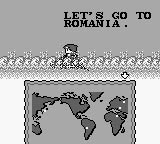
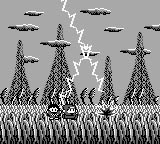
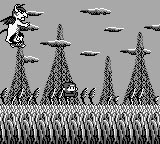

You now have two images below. The one on the left is the U.S. image and the one on the right is the Japanese image. If you look in the water, Jajamaru goes topless when he has to do a swimming level. While it may be hard to see it, Maru is actually still wearing his ninja suit in the U.S. image. WHY? I can't really think of too many reasons. The only thing I could come up with is that "JAWS" may have something to do with it. I'm merely making a wild guess, but perhaps someone was afraid of the whole idea of a topless guy in the water with sharks. However, that idea is automatically shot down and forgotten because you end up topless in both versions when the actual level starts anyway.
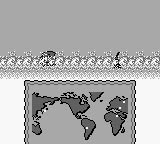

The next image below just shows a stage layout difference. The Romania stage has large crosses that were removed in the U.S. version of the game. Other than this, the rest of the stages seem identical as far as design.
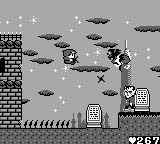
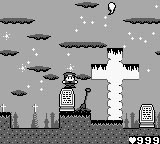
The next image below is for the U.S. game. In the U.S. game, you can also fight a clone of yourself that runs around trying to defeat you. This clone does not appear in the Japanese game. While the clone is a bit cheap, it doesn't really do much to boost the difficulty and like a boss, you can clobber it, gather souls for life, and move on. When you defeat the clone, it dies the same way a mini-boss or boss does.
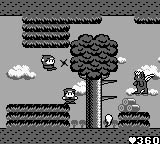
Back to the Game Boy Reviews Page
Back to the Video Game Reviews Page
Back to the Sanctuary Entrance
For more cool stuff, check out the General Gaming Interest and Video Game Scans sections. You can also check us out on Twitter, Facebook, the forum, and our blog.
All content shown in Gaming Sanctuary belong to their respective owners.